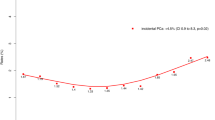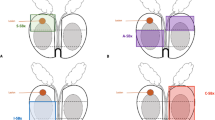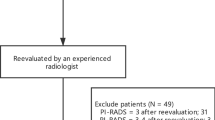Abstract
A series of 212 prostate specimens of men dead between August 2002–August 2004, have been sectioned in consecutive autopsies and subjected to whole mount analysis in purpose to determine the epidemiology of impalpable prostate cancer in Greece. Impalpable prostate carcinomas were found in 40 cases (18.8%) most in the peripheral region. In all, 29 of 40 impalpable cancers (70.7%) had volume less than 1 cm3. Most of impalpable carcinomas were of favorable (Gleason score 2–4) or intermediate (Gleason score 5 and 6) histological type (55 and 27.7%, respectively) while only five (12.5%) were undifferentiated (Gleason score 7 and 8). In all, 24 (60%) of the 40 impalpable carcinomas were multifocal and consisted of two or more foci, most of small size (<0.5 cm3). Most of the impalpable cancers found in this autopsy study were potentially insignificant tumors (relatively low volume, favorable or intermediate histological pattern and absence of invasiveness). Prostate intraepithelial neoplasia (PIN) coexisted with impalpable carcinomas, in almost half of the cancer-positive specimens. There was a positive correlation between PIN foci and coexistent cancer foci in most of the cases. Frequency rate and pathological features of both entities show significant variations in medical literature. Since the incidence of clinical prostate cancer in Greece is relatively low, and according to our autopsy findings, it is plausible that the frequency of clinical prostate cancer in a certain population could be related to the prevalent model of impalpable cancer as well as to the frequency and extend of the precancerous lesions.
This is a preview of subscription content, access via your institution
Access options
Subscribe to this journal
Receive 4 print issues and online access
$259.00 per year
only $64.75 per issue
Buy this article
- Purchase on Springer Link
- Instant access to full article PDF
Prices may be subject to local taxes which are calculated during checkout
Similar content being viewed by others
References
Henson DE, Hutter RP, Farrow G . Practice protocol for the examination of specimens removed from patients with carcinoma of the prostate gland A publication of the cancer Committee, College of American Pathologists. Arch Pathol Lab Med 1994; 118: 779–783.
Sesterhenn IA . Prostate and testis tumor. AFIP Genitourinary pathology: WHO Classification of tumors pathology and genetics of the tumors of the urinary system and male genital organs. WHO: Washington, USA, 2003.
Montironi R, Mazzuccheli R, Kwast T . Morfological assesment of radical prostatectomy specimens. A protocol with clinical relevance. Virch Arch 2003; 442: 211–217.
Bostwick GD . Neoplasms of the prostate. In: Bostwick DG, Eble JN (eds). Urologic Surgical Pathology. Mosby: St Louis, 1990.
Nicolo G, Salvi S, Musso C, Amore E . Latent carcinoma of the prostate. Autopsy study of 100 cases. Patologica 1986; 78: 579–591.
Sánchez-Chapado M, Olmedilla G, Cabeza M, Donat E, Ruiz A . Prevalence of prostate cancer and prostatic intraepithelial neoplasia in Caucasian Mediterranean males: an autopsy study. The Prostate 2003; 54: 238–247.
Tiszlavicz L, Szalay I . Multiple urologic tumors in autopsy material. Orv Hetil 1993; 134: 577–581.
Harbitz TB, Haugen OA . Histology of the prostate in elderly men: a study in an autopsy series. Acta Pathol Microbiol Scand [A] 1972; 80: 756–768.
Hollund B . Latent prostate cancer in a consecutive autopsy series. Scand Journ of Urol Nerhrol 1980; 14: 29–35.
Schutze U . Latent prostatic carcinoma – an autopsy study of men over 50 years of age. Zentralbl Allg Pathol 1984; 129: 357–364.
Billis A . Latent carcinoma and atypical lesions of prostate. An autopsy study Urology 1986; 28: 324–329.
Gronberg H . Prostate cancer epidemiology. Lancet 2003; 361: 859–864.
Karakoukis N . Latent carcinoma of the prostate. Unpublished PhD. Athens 1990.
Mettlin CJ, Murphy G . The National Cancer Data Base report on prostate cancer. Cancer 1994; 74: 1640–1648.
Lu-Yao GL, Greenberg ER . Changes in prostate cancer incidence and treatment in the USA. Lancet 1994; 343: 251–254.
Breslow N, Chan CW, Dhom G, Drur-y RA, Franks LM, Gellei B et al. Latent carcinoma of prostate in seven areas. Int J Cancer 1977; 20: 680–688.
Rullis I, Shaeffer JA, Lilien OM . Incidence of prostatic carcinoma in the elderly. Urology 1975; 6: 295–297.
Suen KC, Lau LL, Yermakov V . Cancer and old age. An autopsy study of 3,535 patients over 65 years old. Cancer 1974; 33: 1164–1168.
Vitanen I, Hellens A . Latent carcinoma of the prostate in Finland. Acta Pathol Microbiol Scand 1958; 44: 64–67.
Takahashi S, Shirai T, Hasegawa R, Imaida K, Ito N . Latent prostatic carcinomas found at autopsy in men over 90 years old. Jpn J Clin Oncol 1992; 22: 117–121.
Guileyardo J, Johnson W, Welsh R, Akazaki K, Correa P . Prevalence of latent prostatic carcinoma in two US populations. J Nat Cancer Inst 1980; 65: 311–316.
Muir CS, Nectoux J, Staszewski J . The epidemiology of prostate cancer. Geographical distribution and time-trends. Acta Oncol 1991; 30: 133–140.
Yatani R, Shiraishi T, Makakuki K, Takanari H, Hayashi T, Stemmermann G . Trends in frequency of latent prostate carcinoma in Japan from 1965–1979 to 1982–1986. Jour Natl Cancer Inst 1988; 80: 683–687.
Gatling RR . Prostate carcinoma: an autopsy evaluation of the influence of age, tumor grade, and therapy on tumor biology. South Med J 1990; 83: 782–784.
Epstein JI, Walsh PC, Brendler CB . Radical prostatectomy for impalpable prostate cancer: the Johns Hopkins experience with tumors found on transurethral resection (stages T1A and T1B) and on needle biopsy (stage T1C). J Urol 1994; 152 (Part 2): 1707–1708.
Newman Jr AJ, Graham MA, Carlton Jr CE, Lieman S . Incidental carcinoma of the prostate at the time of transurethral resection: importance of evaluating every chip. J Urol 1982; 128: 948–950.
Arora R, Koch MO, Eble JN, Ulbright TM, Li L, Cheng L . Heterogeneity of Gleason grade in multifocal adenocarcinoma of the prostate. Cancer 2004; 100: 2362–2366.
Fukagai T, Namiki T, Namiki H, Carlile RG, Shimada M, Yoshida H . Discrepancies between Gleason scores of needle biopsy and radical prostatectomy specimens. Pathol Int 2001; 51: 364–370.
Aihara M, Sheeler TM, Ohori M . Heterogeneity of prostate cancer in radical prostatectomy specimens. Urol 1994; 43: 60–66.
Whittemore AS, Keller JB, Betensky R . Low-grade, latent prostate cancer volume: predictor of clinical cancer incidence? J Natl Canccr Inst 1991; 83: 1231–1235.
Matsusima H . Correlation of atypical hyperplasia and latent carcinoma of the prostate. Nippon Hinyokika Gakkai Zasshi 1991; 82: 1821–1828.
Sakr WA, Grignon DJ, Haas GP . Pathology of premalignant lesions and carcinoma of the prostate in African-American men. Semin Urol Oncol 1998; 16: 214–220.
Sakr WA, Grignon DJ, Crissman JD, Heilbrun LK, Cassin BJ, Pontes JJ et al. High grade prostatic intraepithelial neoplasia (HGPIN) and prostatic adenocarcinoma between the ages of 20–69: an autopsy study of 249 cases. In vivo 1994; 8: 439–443.
Puig-Sureda I, Lopez Duesa L, Rodriguez-Vallejo JM, Gonzalez- Esteban J . Relationship of prostatic carcinoma of the peripheral zone with glandular atrophy and prostatic intraepithelial neoplasia. Actas Urol Esp 1997; 21: 40–43.
Sanchez Chapado M, Angulo J, Cabeza M, Donat E, Ruiz A, Olmedilla G et al. Prevalence of prostatic intraepithelial neoplasia in Spain. Arch Esp Urol 2001; 54: 1103–1109.
Author information
Authors and Affiliations
Corresponding author
Rights and permissions
About this article
Cite this article
Stamatiou, K., Alevizos, A., Perimeni, D. et al. Frequency of impalpable prostate adenocarcinoma and precancerous conditions in Greek male population: an autopsy study. Prostate Cancer Prostatic Dis 9, 45–49 (2006). https://doi.org/10.1038/sj.pcan.4500847
Received:
Revised:
Accepted:
Published:
Issue Date:
DOI: https://doi.org/10.1038/sj.pcan.4500847
Keywords
This article is cited by
-
Comparison of malignancy and spatial distribution between latent and clinical prostate cancer: an 8-year biopsy study
European Journal of Medical Research (2022)



